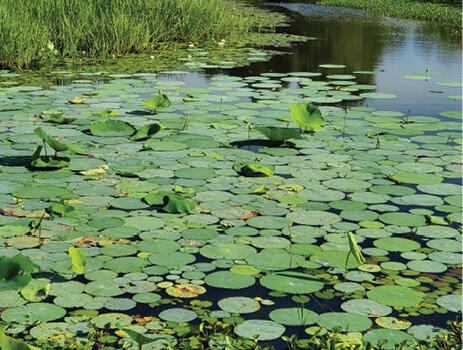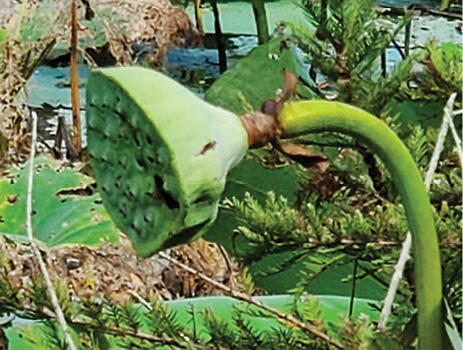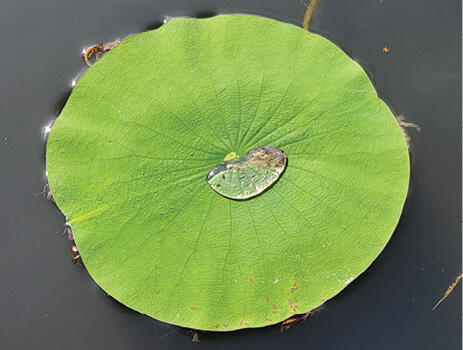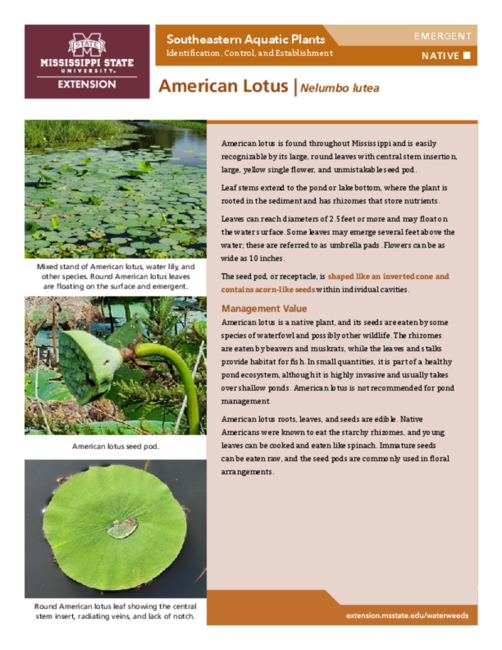P3735-16
American Lotus | Nelumbo lutea

Round American lotus leaves are floating
on the surface and emergent.


radiating veins, and lack of notch.
American lotus is found throughout Mississippi and is easily recognizable by its large, round leaves with central stem insertion, large, yellow single flower, and unmistakable seed pod.
Leaf stems extend to the pond or lake bottom, where the plant is rooted in the sediment and has rhizomes that store nutrients.
Leaves can reach diameters of 2.5 feet or more and may float on the water surface. Some leaves may emerge several feet above the water; these are referred to as umbrella pads. Flowers can be as wide as 10 inches.
The seed pod, or receptacle, is shaped like an inverted cone and contains acorn-like seeds within individual cavities.
Management Value
American lotus is a native plant, and its seeds are eaten by some species of waterfowl and possibly other wildlife. The rhizomes are eaten by beavers and muskrats, while the leaves and stalks provide habitat for fish. In small quantities, it is part of a healthy pond ecosystem, although it is highly invasive and usually takes over shallow ponds. American lotus is not recommended for pond management.
American lotus roots, leaves, and seeds are edible. Native Americans were known to eat the starchy rhizomes, and young leaves can be cooked and eaten like spinach. Immature seeds can be eaten raw, and the seed pods are commonly used in floral arrangements.
Recommended Controls
Option 1: 2,4-D (3.8-pound formulation). For each gallon of water, mix 5.1 ounces of 2,4-D, 1.3 ounces of surfactant. Spray to wet all exposed plants. Do not exceed annual herbicide rate limits as stated on the product label.
Option 2: Diquat (3.73-pound formulation). Diquat (0.25 gallon per acre-foot of water) should be applied as a submersed injection (application using a wand or hose). Determine pond volume prior to application. Dilute 1 part diquat with 9 parts water. Inject the formula using a boat and motor. Do not exceed annual herbicide rate limits as stated on the product label.
NOTE: Acre foot = average depth of pond multiplied by pond acreage; average depth is calculated by taking the depth at 20 points across a water body and averaging the values.
Option 3: Triclopyr (3.0-pound formulation). For each gallon of water, mix 5.1 ounces of triclopyr, 1.3 ounces of surfactant. Spray to wet all exposed plants. Do not exceed annual herbicide rate limits as stated on the product label.
For heavy coverage, treat one-third of pond at a time with 1–2 weeks between applications for both Options 1 and 2.
Read and follow all chemical label instructions, especially the section on the use of personal protection equipment.

The information given here is for educational purposes only. References to commercial products, trade names, or suppliers are made with the understanding that no endorsement is implied and that no discrimination against other products or suppliers is intended.
Publication 3735-16 (POD-11-23)
By Wes Neal, PhD, Extension/Research Professor, Wildlife, Fisheries, and Aquaculture; Dennis Riecke, Fisheries Coordinator, Mississippi Department of Wildlife, Fisheries, and Parks; and Gray Turnage, PhD, Assistant Research/Extension Professor, GeoSystems Research Institute.
The Mississippi State University Extension Service is working to ensure all web content is accessible to all users. If you need assistance accessing any of our content, please email the webteam or call 662-325-2262.
